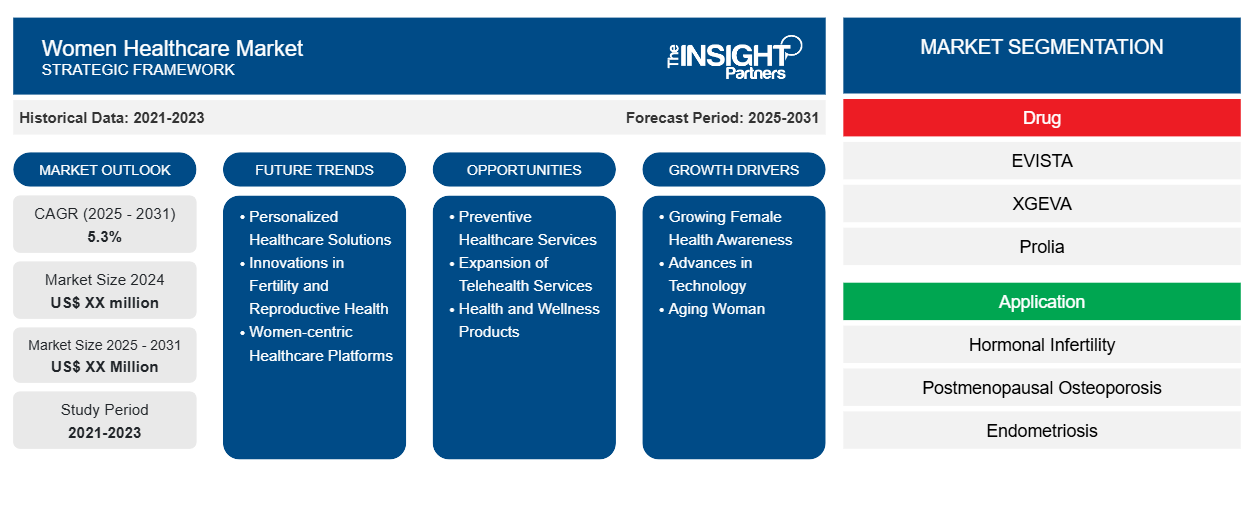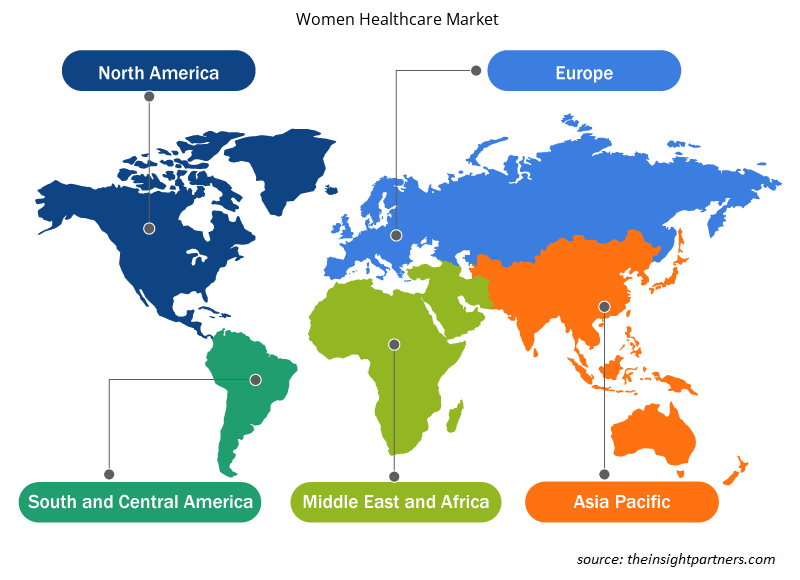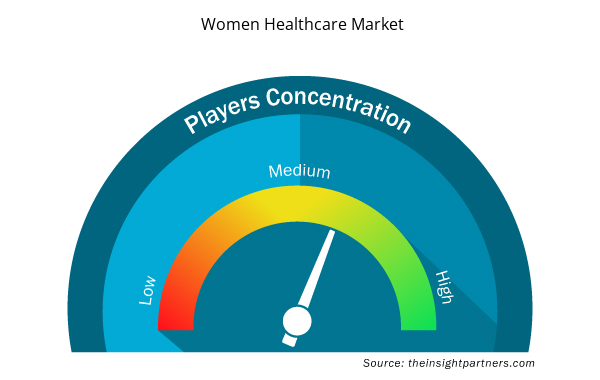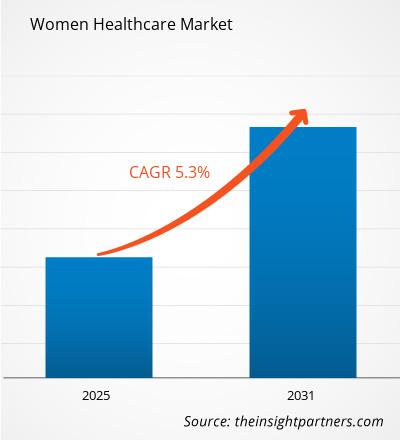The Women Healthcare Market is expected to register a CAGR of 5.3% from 2025 to 2031, with a market size expanding from US$ XX million in 2024 to US$ XX Million by 2031.
The report is segmented by Drug (EVISTA, XGEVA, Prolia, Mirena, Zometa, Reclast/Aclasta, Others). Futher, it is segmented based on Application (Hormonal Infertility, Postmenopausal Osteoporosis, Endometriosis, Contraceptives, Menopause, Others). The global analysis is further broken-down at regional level and major countries. The report offers the value in USD for the above analysis and segments.
Purpose of the Report
The report Women Healthcare Market by The Insight Partners aims to describe the present landscape and future growth, top driving factors, challenges, and opportunities. This will provide insights to various business stakeholders, such as:
- Technology Providers/Manufacturers: To understand the evolving market dynamics and know the potential growth opportunities, enabling them to make informed strategic decisions.
- Investors: To conduct a comprehensive trend analysis regarding the market growth rate, market financial projections, and opportunities that exist across the value chain.
- Regulatory bodies: To regulate policies and police activities in the market with the aim of minimizing abuse, preserving investor trust and confidence, and upholding the integrity and stability of the market.
Women Healthcare Market Segmentation
Drug
- EVISTA
- XGEVA
- Prolia
- Mirena
- Zometa
- Reclast/Aclasta
- Others
Application
- Hormonal Infertility
- Postmenopausal Osteoporosis
- Endometriosis
- Contraceptives
- Menopause
- Others
Customize This Report To Suit Your Requirement
You will get customization on any report - free of charge - including parts of this report, or country-level analysis, Excel Data pack, as well as avail great offers and discounts for start-ups & universities
Women Healthcare Market: Strategic Insights

- Get Top Key Market Trends of this report.This FREE sample will include data analysis, ranging from market trends to estimates and forecasts.
Women Healthcare Market Growth Drivers
- Growing Female Health Awareness: Increasing the interest of women in preventive care and wellness is fueling the demand for women-related healthcare services, where increasingly women are taking interest in their health.
- Advances in Technology: The acceptance of telemedicine, AI, and wearable health tech boosts women's healthcare with respect to increased accessibility and tailored care.
- Aging Woman: An aging woman would suffer from chronic diseases and conditions which increase the demand for healthcare in the areas of menopause health, osteoporosis care, and cardiovascular health.
Women Healthcare Market Future Trends
- Personalized Healthcare Solutions: Genotype-and lifestyle-based treatments are fast gaining ground, hence better and personal care for women.
- Innovations in Fertility and Reproductive Health: Advancements in fertility treatments, egg freezing, and family planning apps are shaping the reproductive health segment and offering more choices to women on reproductive rights.
- Women-centric Healthcare Platforms: Digital health platforms focused on female-specific health concerns such as menstrual tracking and menopause management are gaining traction.
Women Healthcare Market Opportunities
- Preventive Healthcare Services: Early disease detection and prevention services, including screenings for breast cancer and cervical health, are growth opportunities.
- Expansion of Telehealth Services: Expansion of telehealth for women's health consultations continues to reach underserved populations, especially in rural areas.
- Health and Wellness Products: Women's health supplements, organic skincare, and wellness products are in increasing demand as women focus more on self-care.
Women Healthcare Market Regional Insights
The regional trends and factors influencing the Women Healthcare Market throughout the forecast period have been thoroughly explained by the analysts at Insight Partners. This section also discusses Women Healthcare Market segments and geography across North America, Europe, Asia Pacific, Middle East and Africa, and South and Central America.

- Get the Regional Specific Data for Women Healthcare Market
Women Healthcare Market Report Scope
| Report Attribute | Details |
|---|---|
| Market size in 2024 | US$ XX million |
| Market Size by 2031 | US$ XX Million |
| Global CAGR (2025 - 2031) | 5.3% |
| Historical Data | 2021-2023 |
| Forecast period | 2025-2031 |
| Segments Covered |
By Drug
|
| Regions and Countries Covered | North America
|
| Market leaders and key company profiles |
Women Healthcare Market Players Density: Understanding Its Impact on Business Dynamics
The Women Healthcare Market market is growing rapidly, driven by increasing end-user demand due to factors such as evolving consumer preferences, technological advancements, and greater awareness of the product's benefits. As demand rises, businesses are expanding their offerings, innovating to meet consumer needs, and capitalizing on emerging trends, which further fuels market growth.
Market players density refers to the distribution of firms or companies operating within a particular market or industry. It indicates how many competitors (market players) are present in a given market space relative to its size or total market value.
Major Companies operating in the Women Healthcare Market are:
- Bayer AG
- Allergan
- Merck & Co.
- Pfizer Inc.
- Amgen
Disclaimer: The companies listed above are not ranked in any particular order.

- Get the Women Healthcare Market top key players overview
Key Selling Points
- Comprehensive Coverage: The report comprehensively covers the analysis of products, services, types, and end users of the Women Healthcare Market, providing a holistic landscape.
- Expert Analysis: The report is compiled based on the in-depth understanding of industry experts and analysts.
- Up-to-date Information: The report assures business relevance due to its coverage of recent information and data trends.
- Customization Options: This report can be customized to cater to specific client requirements and suit the business strategies aptly.
The research report on the Women Healthcare Market can, therefore, help spearhead the trail of decoding and understanding the industry scenario and growth prospects. Although there can be a few valid concerns, the overall benefits of this report tend to outweigh the disadvantages.
- Historical Analysis (2 Years), Base Year, Forecast (7 Years) with CAGR
- PEST and SWOT Analysis
- Market Size Value / Volume - Global, Regional, Country
- Industry and Competitive Landscape
- Excel Dataset


- Print Management Software Market
- Smart Grid Sensors Market
- Pharmacovigilance and Drug Safety Software Market
- Artificial Intelligence in Defense Market
- Airport Runway FOD Detection Systems Market
- Human Microbiome Market
- Oxy-fuel Combustion Technology Market
- Railway Braking System Market
- Wind Turbine Composites Market
- Antibiotics Market

Report Coverage
Revenue forecast, Company Analysis, Industry landscape, Growth factors, and Trends

Segment Covered
Drug, Application, and Geography

Regional Scope
North America, Europe, Asia Pacific, Middle East & Africa, South & Central America

Country Scope
US, UK, Canada, Germany, France, Italy, Australia, Russia, China, Japan, South Korea, Saudi Arabia, Brazil, Argentina
Frequently Asked Questions
The major factors driving the women healthcare market are:
1. Growing Female Health Awareness.
2. Aging Woman.
North America region accounts for highest revenue share in women healthcare market.
Asia Pacific is estimated to grow at the highest CAGR over the forecast period (2023 - 2031).
The women healthcare market is expected to grow at a CAGR of 5.3%.
The final report will duly include market size and projection estimates for all the segments from 2021 to 2031, along with a revenue share and compound annual growth rate (%) for the regional/country-wise market wherein 2021-2022 are the historic years, 2023 is considered to be the base year, and the forecast will be provided till 2031, along with CAGR (%).
Bayer AG and Allergan are the major companies operating in the women healthcare market.
Trends and growth analysis reports related to Life Sciences : READ MORE..
The List of Companies
1. Bayer AG
2. Allergan
3. Merck & Co.
4. Pfizer Inc.
5. Amgen
6. Agile Therapeutics Inc.
7. Ferring Pharmaceuticals
8. Mylan N.V.
9. Lupin
10. Blairex Laboratories
11. Apothecus Pharmaceutical
12. Eli Lilly and Company
13. Novartis AG
14. Johnson & Johnson
15. AstraZeneca
16. Bristol-Myers Squib

 Get Free Sample For
Get Free Sample For